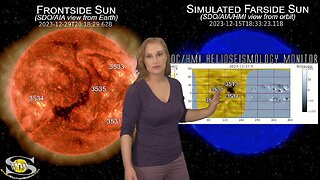A Blackstar During the Solar Minimum Low: Solar Storm Forecast 07-06-2019
This Solar Storm Forecast is sponsored in part by 3ric Johanson: http://instagram.com/scubist
Note: A new high latitude sunspot is emerging in the southern hemisphere now. It is likely from the upcoming solar cycle 25! If it persists, I will highlight it in my next forecast.
This week, we are still riding the high of the total solar eclipse back on July 2nd as space weather picks up. Two bright regions have returned to Earth view (along with what looks to be a newly emerging sunspot in the southern hemisphere, likely from the upcoming cycle 25!) The returning bright regions are sandwiched by two coronal holes. The first has already rotated into the Earth-strike zone and is sending us a small pocket of fast solar wind. The disturbance has been extremely mild thus far and will likely bring only unsettled conditions and possibly some aurora at high latitudes. After we settle down over the next couple of days, the second coronal hole will bump activity back up around Tuesday of this next week. We could get another chance for storming and aurora at high latitudes, but only a minor chance of storming at mid-latitudes. Meanwhile, the bright regions are definitely decaying and are only boosting the solar flux slightly. This means amateur radio and emergency responders are still suffering with poor radio propagation on Earth's dayside. The only group, who should be loving life right now are GPS/GNSS users. The mild disturbance and low solar flux combine to help improve reception, especially at low latitudes so GPS users should enjoy decent reception all over. Catch up on some amazing views of our "Blackstar" during totality, see where aurora and noctilucent clouds were caught this past week, and learn what else our Sun has in store.
Want early viewing of these forecasts? Check out my community on Patreon:
http://patreon.com/SpaceWeatherWoman
For daily and often hourly updates (during active times) visit me on Twitter:
https://twitter.com/TamithaSkov
For a more in-depth look at the data and images in this video see links in my prior videos. I am saving room here for links to the field reporter images highlighted this week!
Field Reporter Photography:
Ward Bruggeman, ESO’s La Silla Observatory in Chile:
https://twitter.com/Ward_Weerman/status/1146157081591984137
Universidad Católica de Chile, Elqui Valley, in northern Chile:
https://twitter.com/ucatolica_chile/status/1146173291893272576
Lenny de Vries, La Serena, Chile:
https://twitter.com/Lenny_deVries/status/1146222076828749827
Daniel Fischer, Puclaro Lake, Chile:
https://twitter.com/cosmos4u/status/1146215197981511680
Alba Garcia, Chile:
https://twitter.com/albamistic/status/1146196002094952448
Adrien Mauduit, Mountains near La Serena, Chile:
https://twitter.com/NightLights_AM/status/1146455484616126464
David McColm, Pacific Ocean, Chile:
https://twitter.com/triwhistler/status/1146459051892649984
Notanee Bourassa, Regina, Saskatchewan, Canada:
https://twitter.com/DJHardwired/status/1145722911514419200
Deb Maluk, Sandy Lake, Manitoba, Canada:
https://twitter.com/dmaluk1/status/1145581158140448769
https://twitter.com/dmaluk1/status/1145611180225916928
Dar Tanner, Alix, Alberta, Canada:
https://twitter.com/dartanner/status/1145067412569485312
Anne-Marie Gutschlag, Invercargill, New Zealand:
https://twitter.com/AnneMarie224/status/1145639926613991425
Images c/o NASA/ESA/CSA (most notably the superb SDO, SOHO, ACE, STEREO, CCMC, JPL & DSN teams, amazing professionals, hobbyists, institutions, organizations, agencies and amateurs such as those at the USAF/HAARP, NICT, NOAA, USGS, Environment Canada, Natural Resources Canada, Intellicast, Catatania, rice.edu, wisc.edu, sonoma.edu ucalgary.ca, rssi.ru, ohio-state.edu, solen.info, and more. Thanks for making Space Weather part of our every day dialogue.
-
 9:46
9:46
Dr. Tamitha Skov
4 months ago $0.02 earnedDark Farside Regions Come with Aurora & Meteors for New Years | Space Weather News 30 December 2023
1241 -
 1:27:41
1:27:41
Clownfish TV
23 hours agoYasuke Wikipedia Drama, CD Projekt Red Menstruation Award | CTRL+STREAM+DEL Livestream #04
645 -
 1:57:35
1:57:35
Robert Gouveia
5 hours agoIT'S OVER: Cohen ADMITS to CRUSHING LIES; Trump Prosecution DESTROYED; Trial Day 19
30.3K27 -
 2:00:08
2:00:08
Cigar prop
3 days ago $0.02 earnedIzzy Woods of Drew Estate Cigars, I'd Tap That Cigar Show Episode 232
5.34K -
 1:43:54
1:43:54
2 MIKES LIVE
8 hours ago#68 2ML Tonight's guest Jeremy Carl, author of The Unprotected Class!
8.17K2 -
 54:44
54:44
The Amber May Show
1 day agoMovie | War On Truth | Federal Government Has Waged a War On Truth | Nick Searcy
11.5K1 -
 56:41
56:41
Donald Trump Jr.
8 hours agoCOHEN CAUGHT IN LIES AND THEFT: This is Bragg’s Star Witness? My Response | TRIGGERED Ep.138
64.8K166 -
 1:52:58
1:52:58
The Quartering
6 hours agoTrump Trial Collapses, Iran President Kaput, War Crimes, CIA Busted In Coup!
51.7K24 -
 2:26:53
2:26:53
WeAreChange
4 hours agoCountdown Underway To New York Leftists Throwing Donald Trump In Jail?!
32.7K20 -
 1:59:06
1:59:06
Film Threat
9 hours agoAI WILL DESTROY HOLLYWOOD! | Film Threat Versus
20.3K3